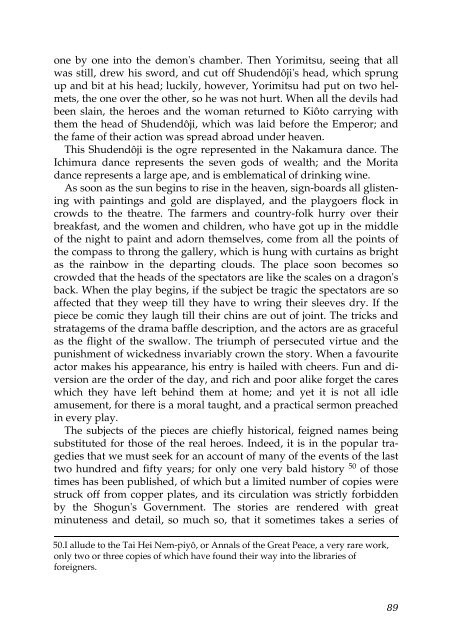Create successful ePaper yourself
Turn your PDF publications into a flip-book with our unique Google optimized e-Paper software.
one by one into the demon's chamber. Then Yorimitsu, seeing that all<br />
was still, drew his sword, and cut <strong>of</strong>f Shudendôji's head, which sprung<br />
up and bit at his head; luckily, however, Yorimitsu had put on two helmets,<br />
the one over the other, so he was not hurt. When all the devils had<br />
been slain, the heroes and the woman returned to Kiôto carrying with<br />
them the head <strong>of</strong> Shudendôji, which was laid before the Emperor; and<br />
the fame <strong>of</strong> their action was spread abroad under heaven.<br />
This Shudendôji is the ogre represented in the Nakamura dance. The<br />
Ichimura dance represents the seven gods <strong>of</strong> wealth; and the Morita<br />
dance represents a large ape, and is emblematical <strong>of</strong> drinking wine.<br />
As soon as the sun begins to rise in the heaven, sign-boards all glistening<br />
with paintings and gold are displayed, and the playgoers flock in<br />
crowds to the theatre. The farmers and country-folk hurry over their<br />
breakfast, and the women and children, who have got up in the middle<br />
<strong>of</strong> the night to paint and adorn themselves, come from all the points <strong>of</strong><br />
the compass to throng the gallery, which is hung with curtains as bright<br />
as the rainbow in the departing clouds. The place soon becomes so<br />
crowded that the heads <strong>of</strong> the spectators are like the scales on a dragon's<br />
back. When the play begins, if the subject be tragic the spectators are so<br />
affected that they weep till they have to wring their sleeves dry. If the<br />
piece be comic they laugh till their chins are out <strong>of</strong> joint. The tricks and<br />
stratagems <strong>of</strong> the drama baffle description, and the actors are as graceful<br />
as the flight <strong>of</strong> the swallow. The triumph <strong>of</strong> persecuted virtue and the<br />
punishment <strong>of</strong> wickedness invariably crown the story. When a favourite<br />
actor makes his appearance, his entry is hailed with cheers. Fun and diversion<br />
are the order <strong>of</strong> the day, and rich and poor alike forget the cares<br />
which they have left behind them at home; and yet it is not all idle<br />
amusement, for there is a moral taught, and a practical sermon preached<br />
in every play.<br />
The subjects <strong>of</strong> the pieces are chiefly historical, feigned names being<br />
substituted for those <strong>of</strong> the real heroes. Indeed, it is in the popular tragedies<br />
that we must seek for an account <strong>of</strong> many <strong>of</strong> the events <strong>of</strong> the last<br />
two hundred and fifty years; for only one very bald history 50 <strong>of</strong> those<br />
times has been published, <strong>of</strong> which but a limited number <strong>of</strong> copies were<br />
struck <strong>of</strong>f from copper plates, and its circulation was strictly forbidden<br />
by the Shogun's Government. The stories are rendered with great<br />
minuteness and detail, so much so, that it sometimes takes a series <strong>of</strong><br />
50.I allude to the Tai Hei Nem-piyô, or Annals <strong>of</strong> the Great Peace, a very rare work,<br />
only two or three copies <strong>of</strong> which have found their way into the libraries <strong>of</strong><br />
foreigners.<br />
89



